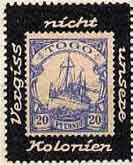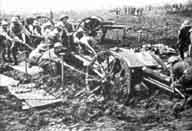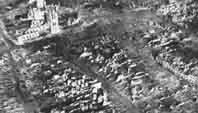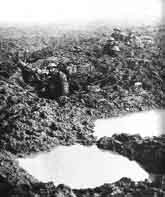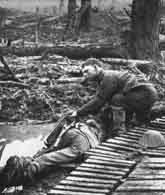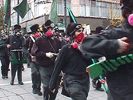 |

|
 |
LEST
WE FORGET:
What was the First World War
all about?
Part One Read Part Two

The
battle zone, World War I.
|
British capitalists were also anxiously aware of the possibility of Germany gaining access to Europe's riches, and with the invasion of Belgium in 1914, the great fear was that such a nation, with a powerful fleet controlling the Channel ports, could seriously challenge Britain's command of the seas. Britain could not allow this to happen. Lest
we forget
– the action
In the centre of the line, the Allies were driven back to the outskirts of Paris where, in September, the Germans were halted at the Marne River. Counter-attacks by the Allies then pushed the Germans back to the Aisne River by the end of 1914. The front line then stabilised and for 3½ years, trenches and massed artillery transformed the war into a virtual interminable seige, extending from Switzerland to the sea.
|
|
All along this "Western front" the names of obscure towns and villages became immortalised as grim reminders of the obscene indifference that exists towards the expendability and suffering of workers in our present social system, known as "capitalism". Young men were shot, bayonetted, gassed, blown to pieces, or drowned in water-filled shell craters in their tens of thousands . . . human sacrifices to the God of Profit and Commercial Greed.
The fighting in capturing, losing, and re-capturing a few yards of territory under the most horrific conditions and the great expenditure in effort and explosives plus the unacceptable casualties and loss of life . . . all became quite acceptable. The only significant movement, which swayed back and forth, was in the centre of the line between Loos and Verdun, known as the 'Somme Battles.'
Fighting was continuous all along the Western Front but ferocious major battles were unleashed at strategic points. On 22nd April 1915 a heavy bombardment signalled another attempted "break through" by the Germans in the second Battle of Ypres. |
Civilians streamed out of the town and headed south. During the afternoon the Germans launched a poisonous gas attack . . . the first time such a weapon was ever used in warfare. 60,000 allied troops died in this extended battle, during which the Germans advanced 2 miles. This portion of the front was then pounded by artillery shells almost unceasingly for the next 2 years. The region was reclaimed marshland which was used as pasture. Farmers were required by law to maintain drainage ditches which, of course, were quickly wrecked. Rains added to the already soggy terrain which eventually became a landscape of foul-smelling mud, peppered with water-filled shell craters. In time, this treacherous morass would suck in and engulf men, horses, guns and . . . later . . . even tanks! Every new shell explosion would throw up rotted corpses which would slowly sink from view again.
In the Spring of 1916, the Germans launched a massive attack against the French at Verdun. For four months the battle raged and troops on both sides were massacred. The line held, but to relieve the exhausted defenders, the Allies mounted an equally massive offensive against the Germans on the Somme (1st July 1916.) This first Battle of the Somme was aimed at pushing the Germans back on a wide front. A seven-day artillery bombardment was followed by a 'creeping barrage' . . . infantry advancing behind a screen of slowly progressing shell explosions. Constant pressure was applied to the German positions . . . British tanks appeared for the first time in September 1916. The few tanks became ineffective when this area of irrigation and river systems also turned into a quagmire. Conditions worsened during the winter, but the 'push' was resumed in the Spring of 1917. Progress was slow and at a huge cost in lives . . . 600,000 Allies were lost for a gain of about 20 miles. more |
Mayday | Pictures | Contact us | Home | Links | Campaigns | Products | World War 1, part 2
